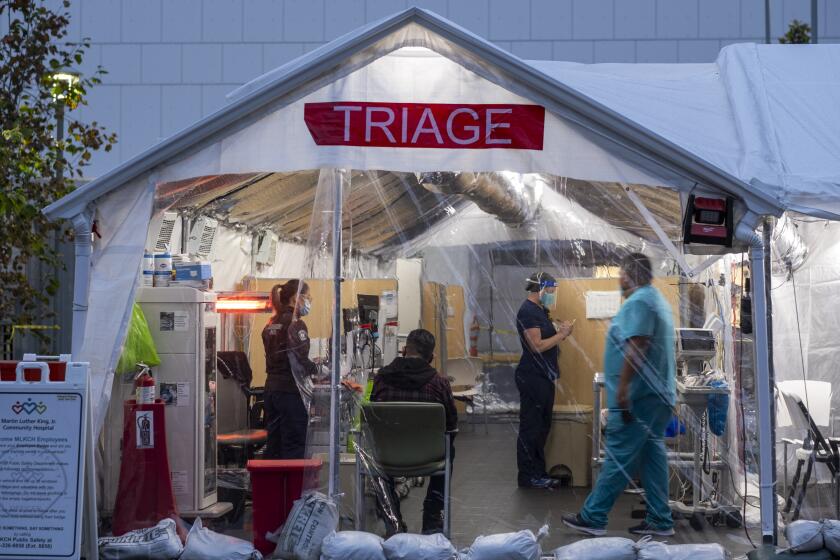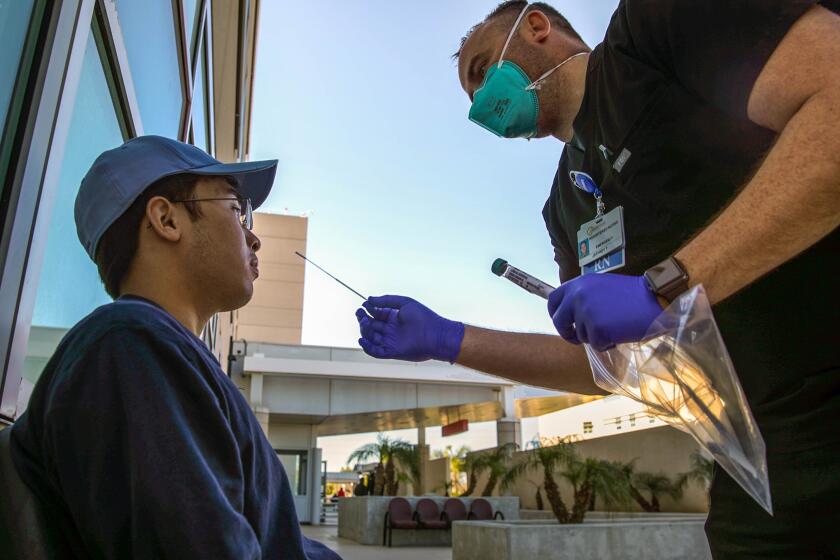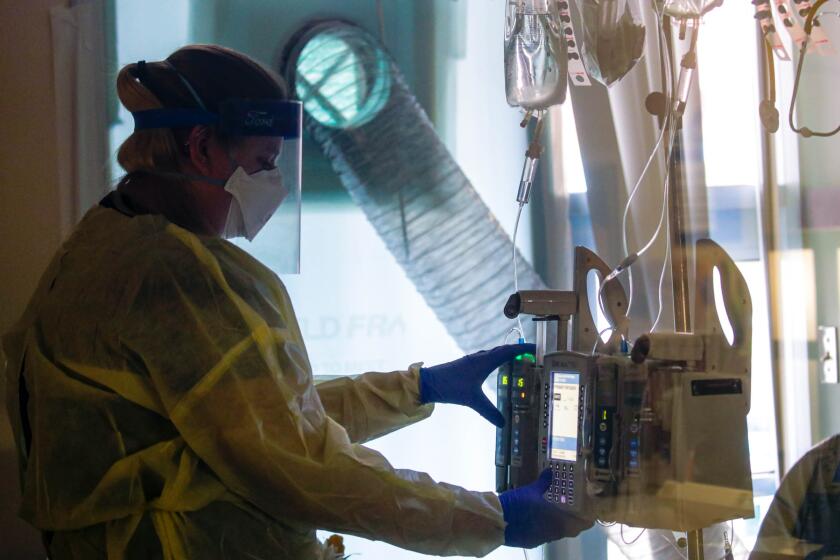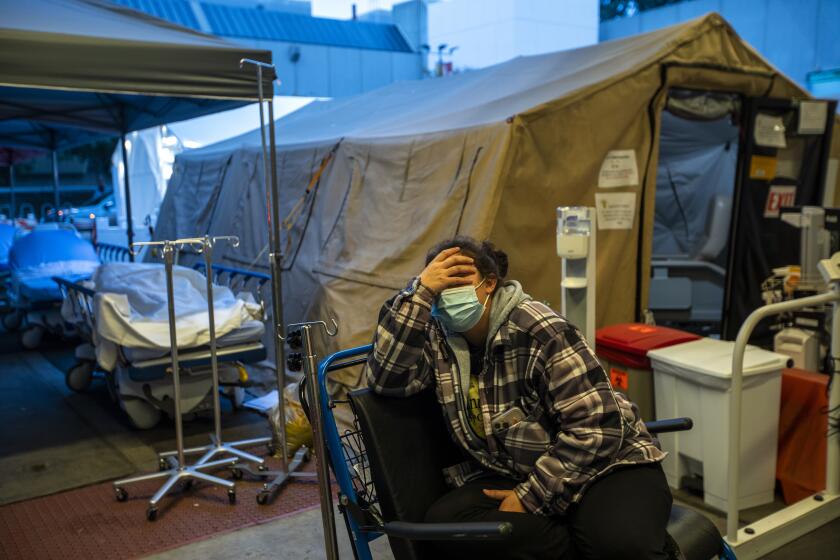California exceeds 8 million coronavirus cases, adding 2.5 million since New Year’s
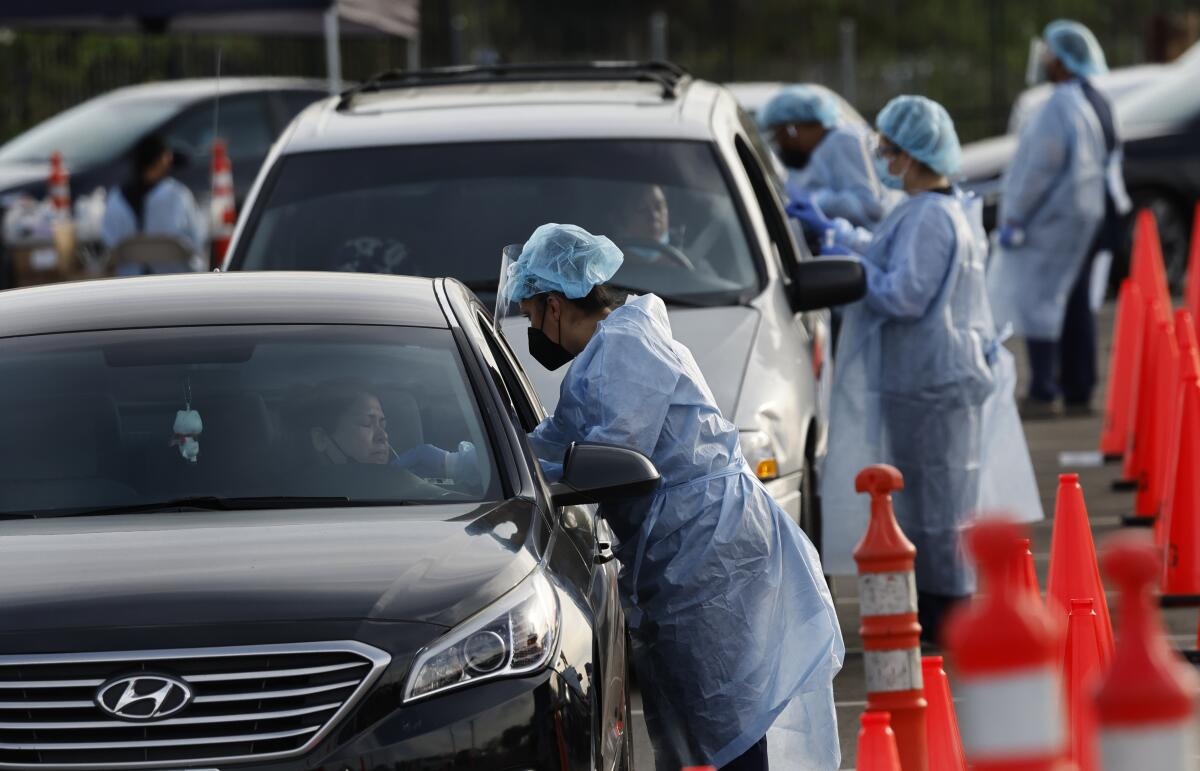
California has now surpassed 8 million cumulative coronavirus cases since the beginning of the pandemic, the end result of weeks of unprecedented spread fueled by the highly infectious Omicron variant.
The milestone, equivalent to roughly 1 out of every 5 residents having been infected at some point, comes amid growing signs that Omicron has finally peaked — but not before tearing through California’s communities. Since New Year’s Day, 2.5 million coronavirus cases have been reported in California. That’s fast approaching the entire statewide caseload reported all of last year: 3.1 million.
And if anything, the recent sky-high numbers are likely an undercount, experts say, as many who may be infected may not get tested because they have only mild symptoms or none at all, while others may use self-administered home tests, whose results are not automatically reported to public health officials.
Daily COVID-19 deaths have also soared in the state in recent weeks. Over the last week, an average of 139 deaths a day have been reported — exceeding the statewide peak from the summer Delta surge of 135 deaths a day. The pandemic has now killed more than 78,300 Californians.
An additional 91 COVID-19 deaths were reported in Los Angeles County on Wednesday, the second-highest daily total of the Omicron surge. One of the deaths was a 15-month-old, the youngest child to die of COVID-19 in the county since the pandemic began, “a stark reminder that the virus can cause devastating outcomes among those most vulnerable, including young children not yet eligible for vaccinations,” health officials said.
Omicron has been so much more transmissible in part because of its robust ability to reinfect people who previously survived earlier coronavirus strains. Omicron has also resulted in more breakthrough infections among vaccinated people.
“Omicron was an eye opener, in part because people who had gotten infected with Delta seem to have almost no protection against Omicron,” Los Angeles County Public Health Director Barbara Ferrer said this week. “And I don’t think Omicron is our last variant.”
Santa Clara County Public Health Director Dr. Sara Cody said she thinks more coronavirus waves are yet to come, but it’s unclear what the next one will look like — whether it will be something little, or another huge mountain.
“The road ahead still has a lot of uncertainty. We don’t know what’s going to come next,” Cody said at a town hall Tuesday night. “The greatest challenge for all of us is that we can’t quite see around every corner.”
L.A. County reported the highest single-day tally of COVID-19 deaths since March 2021 on Thursday.
California reached 6 million reported coronavirus cases on Jan. 10. A week later, on Jan. 17, it surpassed 7 million. The next million took nine more days.
Omicron’s transmissibility has been so breathtaking in scope that it’s hard to visualize just how many more Californians have been simultaneously infected over the last month.
Just in the last two weeks, the number of new infections reported is greater than the populations of San Jose and San Francisco combined.
Over the weeklong period ending Tuesday, California reported an average of 94,000 new coronavirus cases per day — an eye-popping total, but a decrease of about 23% from the peak of the Omicron surge, when 122,000 cases a day were reported between Jan. 10 and 16.
Still, those levels of infection are more than twice as high as the peak seen during the height of last winter’s surge, when 46,000 cases a day were reported.
The Omicron surge has peaked, rather unevenly, in California. But there’s one wrinkle — the emergence of a subtype called BA.2.
But should Omicron behave in California the way it has elsewhere, it’s possible those now-declining numbers will continue to fall, and fast.
Places like New York and Washington, D.C., where the wave arrived earlier, have seen cases decline about as rapidly as they spiked — an experience also shared in the United Kingdom and South Africa, where Omicron was first officially identified.
In California, officials estimate that the statewide effective coronavirus transmission rate as of Wednesday morning was 0.6, meaning each infected resident is transmitting the virus to less than one other person, on average.
A rate of substantially less than 1.0 means that the virus’ spread is likely decreasing.
There remains considerable debate about the pandemic’s trajectory, but scientists generally say it’s too early to declare an ‘endgame’ for COVID-19.
More promising still is that all of the five state-defined regions — the San Francisco Bay Area, Northern California, Greater Sacramento, the San Joaquin Valley and Southern California — have estimated transmission rates that are well below that benchmark, indicating that the virus’ spread is slowing across the Golden State.
“This downward trend is encouraging, and it signals that we’re likely to have passed the peak of Omicron transmission and are beginning to see a real decline in the number of newly infected individuals,” Ferrer said this week.
A rapidly receding wave would be welcome news for California’s beleaguered hospitals, which have for weeks tried to manage a flood of coronavirus-positive patients while dealing with staffing shortages as their own workers became infected.
“I’m hoping that all the reports about Omicron are true, that it does continue to show a reduction in the amount of deaths and hospitalizations. But you have to realize that the sheer number of COVID cases with this surge is so much higher than any other surge,” said Dr. Regina Chinsio-Kwong, a deputy health officer for Orange County.
In previous surges, it typically took about two weeks for increases or decreases in cases to trigger corresponding movement in COVID-19 hospitalizations. However, with data indicating that Omicron is less likely to cause severe illness than its previously dominant Delta cousin, it’s possible the latency period may be shorter this time.
Officials say the Omicron variant has flooded the emergency room at Martin Luther King, Jr. Community Hospital, ground zero for hospitals besieged by a winter surge, with people who are not as sick.
Already, it appears that the number of pandemic-stricken patients may be starting to plateau.
As of Tuesday, 15,279 coronavirus-positive patients were hospitalized statewide. That’s essentially unchanged from a week ago.
By comparison, between Jan. 11 and 18, that hospital census swelled by 23%. Over the prior week, it grew by 53%.
Officials note these figures include both those who are hospitalized specifically for COVID-19 as well as patients who may be seeking care for some other ailment and are found to test positive upon admission.
But whether someone is hospitalized for or with COVID-19, officials say they require resource-intensive precautions to stymie transmission, placing an additional burden on healthcare systems.
Even with the patient count no longer rocketing upward, however, hospitals are still feeling the pinch.
“Although it’s encouraging that Omicron appears to be causing less severe disease, it’s important to remember that we are still facing a high overall burden of disease,” Dr. Rochelle Walensky, director of the U.S. Centers for Disease Control and Prevention, said during a briefing Wednesday. “Hospitalizations have rapidly increased in a short amount of time — putting a strain on many local health systems. Importantly, ‘milder’ does not mean ‘mild,’ and we cannot look past the strain on our health systems and substantial number of deaths ... as a result of the extremely transmissible Omicron variant.”
L.A. County reported the highest single-day tally of COVID-19 deaths since March 2021 on Thursday.
So many nurses are out sick or quarantining at Adventist Health Glendale, President Alice Issai said, that the hospital cannot put patients in all of the beds it has since they cannot be attended to by the needed workers.
That means it takes longer for patients being treated in the emergency room to get admitted, and longer for others to be seen in the ER.
The hospital has relied on traveling nurses and sought to hire more workers. It also is pushing back some surgeries that require a hospital stay.
“It’s an everyday conversation with the surgeons and our operating room staff and our chief of surgery to determine if this [operation being considered] is truly, truly elective, if that can wait maybe one week, two weeks or three weeks,” Issai said.
More to Read
Start your day right
Sign up for Essential California for news, features and recommendations from the L.A. Times and beyond in your inbox six days a week.
You may occasionally receive promotional content from the Los Angeles Times.
